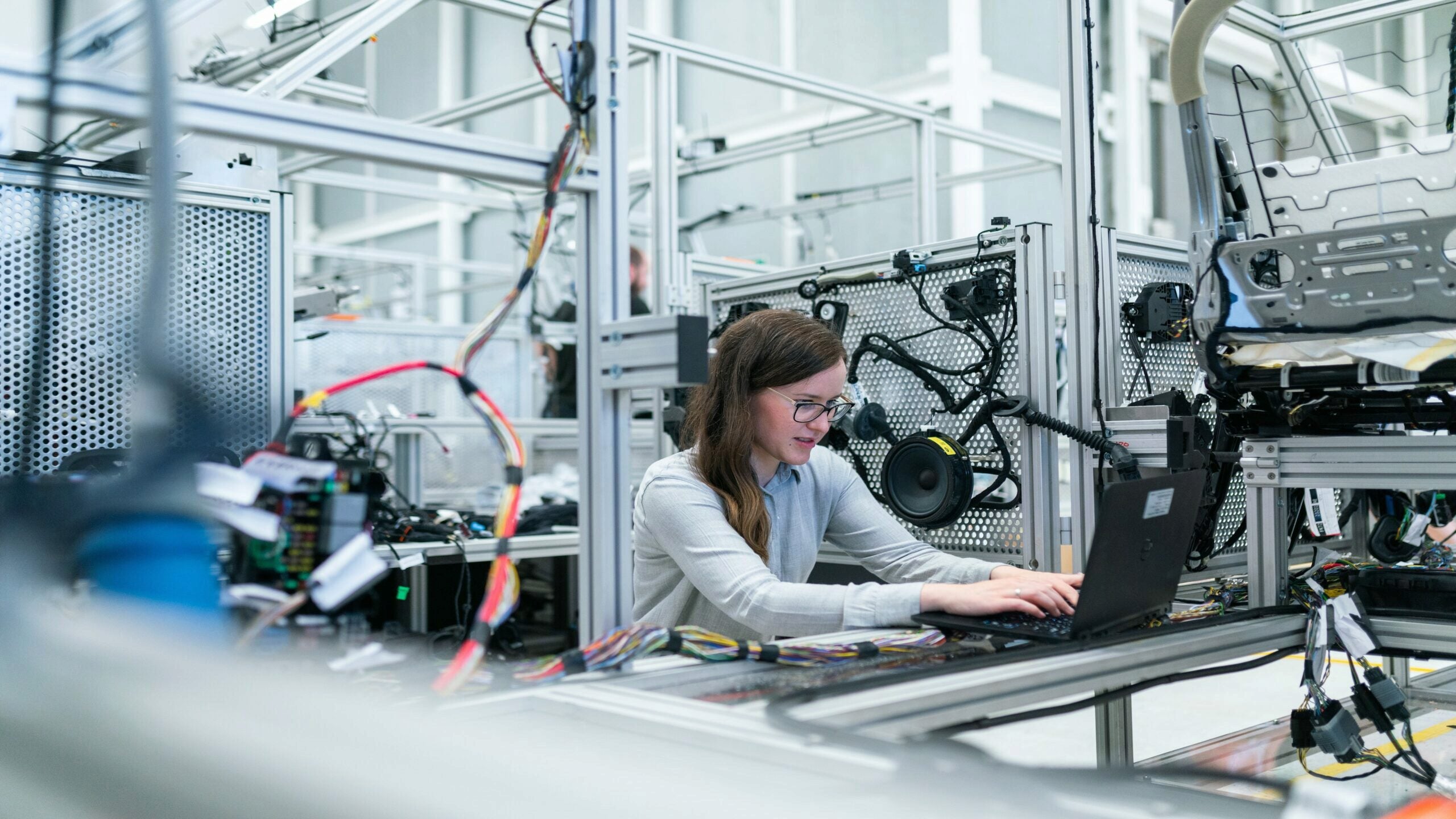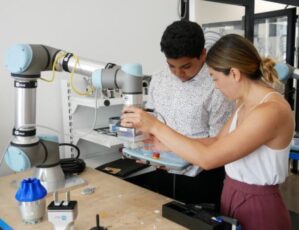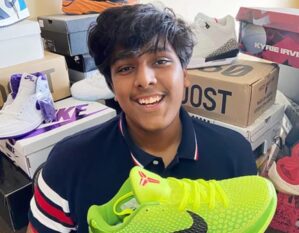My Summer in Tech: 5 Students Connect with Innovation


Entrepreneur Jack Abraham, a Silicon Valley investor and innovator who also served for several years as a client for our Wharton Global High School Investment Competition, shared this observation with high school students around the world: “We are entering an era where technology is transforming everything; it’s transforming every industry and it’s creating and enabling products and services…technology is the future.”
Technological innovation is powering the business world in the 21st century, even more so with life-changing challenges like a global pandemic that have changed our relationship to tech. What would we do, for instance, without Zoom to connect us at school and beyond?
We’re experiencing “a fundamental shift in the way people relate to technology in the world around them,” says Dan Alig, Chief Information Officer at the Wharton School, University of Pennsylvania. “We see that with various technologies. Every time I think about my cell phone and the things that I’m able to do with this small device that fits in my pocket that even five or 10 years ago weren’t nearly as possible. The fact that I can pay at the supermarket with my watch. The way we experience the world with technology is different than even what it was a few years ago.”
High school students are heeding this message of tech dominance to start building their foundations as future business leaders. We heard from a few students who explored technology in different ways this past summer and decided to share their stories.
Robotics in Budapest

Nitin J., a high school junior at BASIS Independent Silicon Valley in San Jose, Calif., has been interested in engineering and technology since middle school, specifically robotics and drones. This summer, Nitin had the opportunity to intern with OnRobot, a global company that designs and sells robotics technologies for different industries. “I wanted to understand the technology behind designing and programming a robotic arm that can mimic the functions of a human hand,” notes Nitin, who worked for two weeks alongside mentor Lizzeth Sanchez in OnRobot’s Budapest, Hungary office. “I was exposed to various forms of robots as well as robotic attachments. All of the robots in their lab consisted of two forms: industrial and collaborative. Industrial robots include those that are very powerful and used in factories on a daily basis. Industrial robots often work with pure code and don’t offer the drag-and-drop functionality of collaborative robots. Collaborative robots on the other hand are simple to learn because of their block programming, and are used in areas where there is human involvement required, such as product finishing. The OnRobot team had me explore different types every day. I was assigned one robot that I would work with, and with the help of applications engineers, I would learn the programming basics for the robot and then learn how to use the robotic attachments to program simple pick and place programs. I learned a plethora of new languages during my stay, including RAPID, Python, SPEL+, Matlab, and simple drag and drop blocks.”
Curious about Crypto
Vanessa M., a 15-year-old from China who is a sophomore at University High in Irvine, Calif., acted on her cryptocurrency curiosity this summer. “I am deeply attracted by this huge and mysterious world,” says Vanessa, who decided to take a class on Edx called “Bitcoin and Cryptocurrency,” which proved to be timely as bitcoin values hit new highs, even while the Chinese government restricted crypto’s development. She went on to write a research report titled “Will Bitcoin Value Go to $1M or $0?” Vanessa’s research opened her eyes to the many technical layers of bitcoin. “Bitcoin has so many technologies involved in it,” she says. “How the transactions work, how the blockchain works, how the mining process works. It is very complicated…This research taught me a new mindset that when some things seem to have a bright future, don’t just blindly follow the crowd to invest in it.”
India’s Sneaker Market

Akshat K., a high school senior from Bangalore, India, is passionate about one thing: bringing the sneaker world from America to India. His business, Deadstock Drip, started in 2018 when he attended SneakerCon L.A. and felt the surge from sneakerheads buying, selling and trading shoes. He wanted to make purchasing high-end sneakers easier for the Indian community and connect Indian sneakerheads with each other. “I started Deadstock Drip as a way to provide Jordans and Yeezys to sneakerheads in my community, but over the year, as I got more and more queries, built a larger customer base that stretched throughout India.” Deadstock Drip is now a global sneaker marketplace that has generated more than $100,000 in profit – and also has lots of tech demands. This summer, Akshat worked on adding two key features to the Deadstock Drip website that he believes will be revolutionary for the sneaker market in India. “The first thing is a live auction house: a subsection of our website that creates a live marketplace where sneakerheads can list their sneakers at an ask while also putting in their bids for other sneakers they are looking to purchase,” says Askshat. “Second is a Find your Sole service. This subsection allows a sneakerhead to search for a sneaker, while also finding a sneakerhead that has their sneaker and is looking to sell it.”
Apps and Analytics
Zach S., a 17-year-old senior from Los Gatos High School in Los Gatos, Calif., spent a big part of his summer launching an app in the Apple app store and on GooglePlay. In 2019, Zach attended a Wharton Summer High School Program on entrepreneurship, working with a small team to develop a business plan for a pre-professional social network directed at high school students. It was a cool idea; in fact, it won first place in the summer business plan competition. After the program ended, Zach couldn’t shake the feeling that they were on to something. Soon after, he started Venzur, a social network for high school students that facilitates collaboration between aspiring young entrepreneurs and keeps students connected through profiles and content. While the website has been operational for a while, the app launched in early September 2021. “It involved going from a small beta site to getting past the rigorous Apple app store review process, which was definitely a challenge,” says Zach, who has been working closely with a few team members including Juan Pablo, a friend he met at Wharton, to connect the app to schools and users around the world. Venzur currently has 100 users – and growing. “I’ve been using Google Analytics since day one. I will make a change to the homepage for part or all of the users and then collect data on Google Analytics for a week on retention rates, average bounce rate, average time spent on the page, then compare that week with the week before and decide if I should do it again. I’m using data to inform how I make all my decisions.”
Meet Glamazontay

Mehtaab B., 17 and a senior from Dublin High School in Dublin, Calif., filled at least part of her summer days as a student in our Wharton Pre-Baccalaureate Program. During her time with Wharton, she discovered new ways to leverage technology. For example, she competed in the Global Youth Meetup challenge Pro Infra, which prompted her to find software that visualizes architecture. When Mehtaab wasn’t studying and competing (by the way, she also took first place in Round 3 of our summer Comment & Win contest), she was building her new online boutique, Athen Collections – with a little help from online tutorials. “YouTube was my main way of learning about starting a boutique,” says Mehtaab. “The main Youtuber I watched was a woman named Glamazontay, and I watched a variety of videos to help me understand every stage of starting a boutique, including legal issues, wholesaling vs. manufacturing, website creation, shipping and marketing. I was given easy ways to work with technology that I hadn’t before, including platforms like Shopify and Mailchimp. Technology can help people cut down useless steps in a process and eliminate waste. Because of this efficiency, I believe technology will make business more accessible for everyone.”
Did you have a recent experience learning and using technology? Share your story in the Comment section of this article.
List 5 different engagements with technology from the article. Which one do you find most interesting and why?
Mehtaab says, “Technology can help people cut down useless steps in a process and eliminate waste.” How do you define the power of technology?
Applause to all the teens mentioned in this article for their extraordinary work in technological innovations! Getting to read all these diverse stories while knowing that there are many others like them around the world has been especially inspiring. However, the one that caught my eye the most was Mehtaab B.’s story regarding starting her own online boutique. Her ability to successfully establish a virtual business owes much credit to the amazing innovations made and to her passion and dedication.
Like Mehtaab, I thought a lot about technology as a resource. As a young child, I enjoyed expressing myself creatively in various ways. I remember being really excited when the release of the iPhone 5 advertised the various media apps that came along with it, but it was a financial luxury for my parents at the time. Thus, I had to resort to more traditional ways of self-expression. I remember the first time I delved into the world of art. Instead of being told what to paint by my instructor, I was given choices: acrylic paint or watercolor, birds or flowers, pink or blue background. Knowing that my choices mattered motivated me to keep painting.
Later on, I was finally able to get my hands on modern technology – an iPad Mini generously gifted to me by my aunt. Through swiping continuously through the App Store, I came across a popular entertainment platform called Youtube in 2016. Familiarizing myself with the app was quite simple and I soon found myself developing preferences for what and who I enjoyed watching. Seeing how my favorite YouTuber Alex Wasabi was able to create funny videos inspired me to start a channel of my own with my cousin. Without hesitation, we quickly grabbed my iPad Mini and opened the camera app, ready to record our first video. After spending hours locked in my bedroom acting out various skits and challenges, it was time to at last upload our videos. However, one challenge stumped us: how to upload the video onto the platform for everyone to see. Just like how Mehtaab learned to set up her boutique, I also watched a variety of videos on Youtube that helped me understand the stages of selecting a video, editing, and uploading it. Without the technology that was available to us at the time, we would have never been able to have the chance to start our own platform.
With that said, Mehtaab’s vision to “leverage technology” applies beyond business interests; it can also be used in simple self-expression. The pure joy and satisfaction that comes from being able to freely showcase your passions and ideas is one that can’t be mimicked elsewhere. With my cousin’s and my efforts combined, we’ve only managed to attract 12 subscribers with an average of 4 likes per video. The lack of an audience didn’t discourage us even once. We had the most fun we ever had because we were able to use the technological innovations available to us to express ourselves in ways like never before. Additionally, it has also allowed us to become problem solvers and creative thinkers. With just a click of a few buttons, I was able to unlock a whole new world of opportunities to further pursue my interests. It is truly jaw-dropping how technology can so drastically change the lives of average high schoolers, and even middle schoolers, too. Without technology, it would be nearly impossible for younger generations today to delve into their business interests and personal passions in such an accessible way.
But while technology can ‘democratize’ who gets to have an online platform, it also excludes those who lack the technological resources in the first place.
Today, most public schools in New York City have adequate technology in their classrooms and libraries. However, there are still many schools, especially in economically disadvantaged areas such as the South Bronx, that are unable to provide up-to-date technology to enrich their students’ learning experience. Given this issue, it’s important for technology to be incorporated into the common core curriculum. This will place a standard to ensure that students all around are educated on how to fully leverage their given resources. In order to achieve all this, governments must provide proper funding to accommodate the budget needed for technology in public schools. Exploring and taking advantage of the vast benefits of technological innovations paints a more vibrant and rich future for everyone and society.
Many thanks to the Wharton Global Youth Program for granting me the privilege to read all these amazing personal stories!
Firstly I would like to say that I really liked your story, especially about your youtube channel, something that just like you I tried to do. I used to make videos about school presentations, showing all the “making of” process, being most part of it slide presentations. Another thing that I used to do in this channel was gameplays that I enjoyed at the time, however it did not work out as expected.
I also agree with you in the fact that technology came to help everyone in many aspects, one of them, and for me the most important one, the access of information, which is helping me a lot on my research projects. The possibility of having all the knowledge of the world within just a few clicks is something unbelievable sometimes. However, just like you said, technology in general is not totally democratized, mainly because of the economical and social problems, but also In the aspect of using it at its “full potential”.
As a Brazilian student, I can tell you that the access to technology in schools,sometimes, is a kind of luxury that can not be afforded. Some schools, especially in the north/east part of the country, don’t have enough money to afford teachers or even desks! Having computers, tvs, and the internet in schools help a lot with the learning process of students. Meanwhile, many people who have a good financial condition, have access to all high tech computers and equipaments, spend most of their time on the internet doing “useless” things while many others that really want to make a change in their lives cannot have those opportunities.
In my opinion, governments, just like the Brazilian one, and especially the American one, could create social and economical politics, or even incorporate NGOs social strategies, such as the works of the NGO ‘Casa Hacker’(Hacker House) which invests in the education of high school students teaching them how to work with electronic components and 3D printing. Another Brazilian NGO which helps in the improvement of the public education Brazillian systems, is ‘Parceiros da Educação’(Partners of Education), which provides public school students the opportunity of working with technology and also other programs.
By utilizing resources that are at one’s disposal, Mehtaab was able to build a successful, operating online boutique. Truly commendable! To increase accessibility at her online store, she should consider utilizing the same resource of Youtube to add a chatbot feature that could streamline commonly asked questions. This could further improve her store’s efficiency and engagement, by implementing a smart feature to her genius tech fashion initiative.